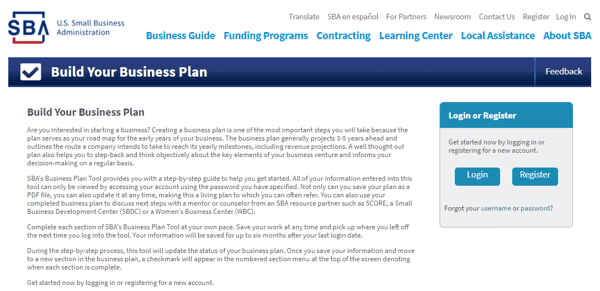
Your business plan is vital to your success, and for more than one reason. First, your business plan provides a strong foundation from which to move forward without losing momentum by wondering what to do next. Second, a well-written business plan is required when presenting your business to potential investors.
Don't be intimidated by the idea of writing. You can start with an informal plan and clean it up later by fitting it into a business plan template when (or if) you're looking to secure a loan. Your starter plan doesn't need to have perfect grammar or really be in any shape to show to investors — that comes later. The most important thing is that you do it!
Below well show you how to write a business plan step-by-step, with 9 key sections that every business plan should include.
Point 1: Your Business Plan Executive Summary
The Executive Summary of your business plan covers the objectives of your business and lays out your mission. It's basically an overview of your business and the problems your business will seek to solve for your clients. Discuss your motivations and business goals. It's recommended to write the Executive Summary last, after you've outlined everything else.
Point 2: Your Business Description
Describe your business from your own point of view and discuss how you plan to grow. Explain where your profits will come from. Explain what kinds of customers you're going to target and how your products or services are going to help them specifically.
Point 3: Market Analysis and Competition
Show that you've thoroughly analyzed the market you're targeting and prove that there's a demand for the product or service you're offering. Include information about the size of your market and how many customers you expect to have, and how many will be repeat customers. Discuss your competition and how your business will stand out from the others.
Point 4: Your Product or Service
Here you explain in detail the product or service at the heart of your business. Remember to lay it out as if you're describing it to someone brand new to your idea (it can be easy to forget to do this and phrase things more for someone already "in-the-know" since that's where you're coming from when you write it).
Point 5: Marketing and Sales Plan
In this section, describe how you'll reach the marketplace you're aiming for. Are you going to create a website and social media profiles? Do you plan to attend trade shows? How about paid advertising? Don't limit yourself to what you'll do at the beginning — if you plan to hold off on paying for ads until later, make a note of that.
Point 6: Ownership, Management, and Personnel
This section includes a description of how you'll staff and manage your business, who the owners are (if more than you alone), and the types of personnel you'll need. Include team members you'll be looking to hire as well as those already working with you at this stage. Write a one-paragraph profile of each existing major team member, including yourself.
Point 7: Financial Plan and Projections
This is a very important section, both for your own planning and especially if you're going to seek investors. Create a cash flow projection to describe your monthly predicted revenue and expenses, a break-even analysis to show how many sales you need to make to cover your initial expenses and make a profit, a sample profit-and-loss statement using anticipated values, and a balance sheet describing your business's current assets, liabilities, and equity. These are the kinds of financial data you'll need to assemble every year at tax time, at which point you'll have real numbers to work with rather than projections.
Point 8: Investment
What will your investors receive, based on your cash flow? This doesn't just include outside investors who you might approach later (and with a more formal business plan). It should also include estimates for the return on investment for anyone who has put money into the formation of the business, like you and anyone you're already working with.
Point 9: Appendices
The appendices are a collection of any supporting data you have, such as testimonials, research excerpts, charts, and other information relevant to your business.
Informal vs. Formal Business Plans
Your informal business plan only needs to be around 10 pages, and you can leave the appendices out if you desire. As mentioned, the informal plan doesn't have to be perfect, but it should still be reasonably professional — you may want to recruit a trusted friend or editor to proofread, for example.
Your formal business plan, on the other hand, can be up to 40 pages and should be written to the best standards you can manage, since the formal plan is the one you'd bring with you to secure a business loan or court investors. The appendices will come in handy here to help convince them of the value of investing in your business. Remember, your formal business plan should be impressive but honest.
Business Plans Templates for Download
- Word Sample Business Plan Template
 Available as a Microsoft Office365 business plan template for Word, it's an 18-page document with step-by-step instructions on how to write a complete business plan.
Available as a Microsoft Office365 business plan template for Word, it's an 18-page document with step-by-step instructions on how to write a complete business plan. - SBA's Business Plan Tool
 Registration with the U.S. Small Business Administration is required, this will give you access to the step-by-step business plan tool.
Registration with the U.S. Small Business Administration is required, this will give you access to the step-by-step business plan tool. - Score.org Business Plan Template for Startups
 Available as a PDF or Word download.
Available as a PDF or Word download. - Lawdepot.com DIY Business Plan generator
 Requires a trial subscription but can generate a formal business plan by following some easy steps.
Requires a trial subscription but can generate a formal business plan by following some easy steps. - One-Page Business Plan PDF from 100Startup.com
 Get started with this simple PDF template to create your business plan.
Get started with this simple PDF template to create your business plan. - Piktochart Market Analysis Report Templates
 See more business report templates by Piktochart.
See more business report templates by Piktochart.
For additional information on how to start an online business you can download our free ebook below.





Leave a reply or comment below